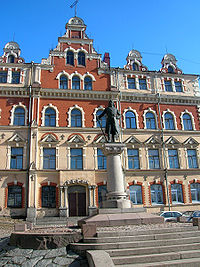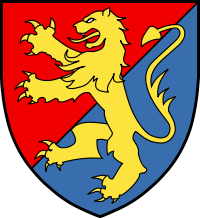
Torkel Knutsson
Encyclopedia

Lord High Constable of Sweden
The Lord High Constable was a prominent and influential office in Sweden, from the 13th century until 1676, excluding periods when the office was out of use. The office holder was a member of the Swedish Privy Council and, from 1630 and on, the head of the Swedish Council of War...
and virtual ruler of Sweden
Sweden
Sweden , officially the Kingdom of Sweden , is a Nordic country on the Scandinavian Peninsula in Northern Europe. Sweden borders with Norway and Finland and is connected to Denmark by a bridge-tunnel across the Öresund....
during the early reign of King Birger Magnusson (1280-1321).
Torkel hailed from an old noble family of West Geat
Västergötland
', English exonym: West Gothland, is one of the 25 traditional non-administrative provinces of Sweden , situated in the southwest of Sweden. In older English literature one may also encounter the Latinized version Westrogothia....
ish ancestry and was related to the Folkung
Folkung
In modern Swedish, Folkung has two meanings, which appear to be opposites:# The medieval "House of Bjelbo" in Sweden, which produced several Swedish statesmen and kings....
s, the royal family, and like them, he had a lion in his coat of arms. He was first mentioned in 1282, and in documents from 1288, he is mentioned as a knight
Knight
A knight was a member of a class of lower nobility in the High Middle Ages.By the Late Middle Ages, the rank had become associated with the ideals of chivalry, a code of conduct for the perfect courtly Christian warrior....
and a member of the privy council (riksråd)
Privy Council of Sweden
The High Council of Sweden or Council of the Realm consisted originally of those men of noble, common and clergical background, that the king saw fit for advisory service...
.
When king Magnus Ladulås died, Torkel became regent
Regent
A regent, from the Latin regens "one who reigns", is a person selected to act as head of state because the ruler is a minor, not present, or debilitated. Currently there are only two ruling Regencies in the world, sovereign Liechtenstein and the Malaysian constitutive state of Terengganu...
for the underage king Birger, being the highest state official and because Magnus' foreign-born widow, Hedwig of Holstein, was not trusted to such powerful position yet.
When Tavastland
Tavastia (historical province)
Tavastia, Tavastland or Häme, Russian Emi or Yemi, is a historical province in the south of Finland. It borders Finland Proper, Satakunta, Ostrobothnia, Savonia and Uusimaa.- Administration :...
had been attacked by the Republic of Novgorod, in 1292, marshal Torkel led the third Swedish crusade
Northern Crusades
The Northern Crusades or Baltic Crusades were crusades undertaken by the Christian kings of Denmark and Sweden, the German Livonian and Teutonic military orders, and their allies against the pagan peoples of Northern Europe around the southern and eastern shores of the Baltic Sea...
against Novgorod, in 1293 and conquered parts of Karelia
Karelia
Karelia , the land of the Karelian peoples, is an area in Northern Europe of historical significance for Finland, Russia, and Sweden...
, where he founded the stronghold of Viborg
Vyborg
Vyborg is a town in Leningrad Oblast, Russia, situated on the Karelian Isthmus near the head of the Bay of Vyborg, to the northwest of St. Petersburg and south from Russia's border with Finland, where the Saimaa Canal enters the Gulf of Finland...
. In 1299-1300, he led an attack against the Novgorodians, and on the Neva River
Neva River
The Neva is a river in northwestern Russia flowing from Lake Ladoga through the western part of Leningrad Oblast to the Neva Bay of the Gulf of Finland. Despite its modest length , it is the third largest river in Europe in terms of average discharge .The Neva is the only river flowing from Lake...
, he founded the fortress of Landskrona
He showed the same concerns about Swedish interior politics. During his regency, the law of Uppland
Uppland
Uppland is a historical province or landskap on the eastern coast of Sweden, just north of Stockholm, the capital. It borders Södermanland, Västmanland and Gästrikland. It is also bounded by lake Mälaren and the Baltic sea...
was established. He acted as Birger Jarl
Birger jarl
, or Birger Magnusson, was a Swedish statesman, Jarl of Sweden and a member of the House of Bjelbo, who played a pivotal role in the consolidation of Sweden. Birger also led the Second Swedish Crusade, which established Swedish rule in Finland. Additionally, he is traditionally attributed to have...
had done in the conflict against the church, in order to abolish the clergy's tax exemption. The clergy's discontent became apparent in 1303.
The old trade treaties with Lübeck
Lübeck
The Hanseatic City of Lübeck is the second-largest city in Schleswig-Holstein, in northern Germany, and one of the major ports of Germany. It was for several centuries the "capital" of the Hanseatic League and, because of its Brick Gothic architectural heritage, is listed by UNESCO as a World...
were re-established, on condition that the town did not provide Novgorod with weapons or provisions.

Valdemar, Duke of Finland
Valdemar Magnusson was a Swedish prince, heir to the throne of Sweden and Duke of Finland.-Background:Valdemar was the third son of King Magnus III of Sweden and his queen Helvig of Holstein. At the coronation of his older brother King Birger of Sweden, Valdemar became the duke of Finland...
, Torkel was faithfully on the king's side. At Torkel's castle Aranäs, in 1304, the two dukes had to sign a declaration that they would neither in Sweden, nor abroad, work against the king nor cause him harm. In spite of this declaration, the two dukes fled abroad and with the support of the Norwegian king Haakon V of Norway
Haakon V of Norway
Haakon V Magnusson was king of Norway from 1299 until 1319.-Biography:Haakon was the younger surviving son of Magnus the Lawmender, King of Norway, and his wife Ingeborg of Denmark. Haakon was descended from king Saint Olav and is considered to have been the last Norwegian king in the Fairhair...
, they attacked Västergötland
Västergötland
', English exonym: West Gothland, is one of the 25 traditional non-administrative provinces of Sweden , situated in the southwest of Sweden. In older English literature one may also encounter the Latinized version Westrogothia....
. Torkel helped the king conquer the castle of Nyköping
Nyköping
Nyköping is a locality and the seat of Nyköping Municipality, Södermanland County, Sweden with 32,427 inhabitants in 2005. The city is also the capital of Södermanland County.- History :...
, which belonged to duke Eric, and in Kolsäter (1305), he forced the two dukes to sign a declaration that they would not cause any harm to Torkel either.
When the power of the dukes was on the rise again, the marshal had to reconcile with the church, and he ordered a charter on the renewal of the church's old rights, in 1305.
However, Torkel was finally struck by the vengeance of his enemies. The dukes managed to win the trust of the king and poisoned the king's mind against his marshal. In December 1305, King Birger and the dukes arrived at Torkel's estate Lena (where formerly the Battle of Lena
Battle of Lena
The Battle of Lena occurred on January 31, 1208, and probably took place near Kungslena , which is located in the Tidaholm Municipality in Västergötland, Sweden....
had taken place) in Västergötland
Västergötland
', English exonym: West Gothland, is one of the 25 traditional non-administrative provinces of Sweden , situated in the southwest of Sweden. In older English literature one may also encounter the Latinized version Westrogothia....
, and arrested Torkel who was taken to Stockholm
Stockholm
Stockholm is the capital and the largest city of Sweden and constitutes the most populated urban area in Scandinavia. Stockholm is the most populous city in Sweden, with a population of 851,155 in the municipality , 1.37 million in the urban area , and around 2.1 million in the metropolitan area...
in chains. In February 1306, the faithful marshal's head was cut off. The dukes were so hateful against Torkel that his body was entered on the place of execution. It was later moved and properly buried at the Franciscan
Franciscan
Most Franciscans are members of Roman Catholic religious orders founded by Saint Francis of Assisi. Besides Roman Catholic communities, there are also Old Catholic, Anglican, Lutheran, ecumenical and Non-denominational Franciscan communities....
church in Stockholm.
Family
Torkel was married twice. His first wife, whose origins are unknown, gave him a daughter named Kristina, who married Torkel's godson and later enemy duke Valdemar. She appears to have been repudiated by the duke upon her father's execution (as Valdemar is soon reported to have married with Ingeborg Eriksdottir of NorwayIngeborg Eriksdottir of Norway
Ingeborg Eriksdottir of Norway was a medieval Norwegian princess and by marriage a Swedish princess, Duchess of Uppland, Öland and Finland, with a seat in the regency government of her nephew, Magnus IV of Sweden.-Family:Ingeborg was the daughter of King Eric II of Norway and Isabel Bruce...
). Torkel's second wife was the countess Hedvig of Ravensberg.

